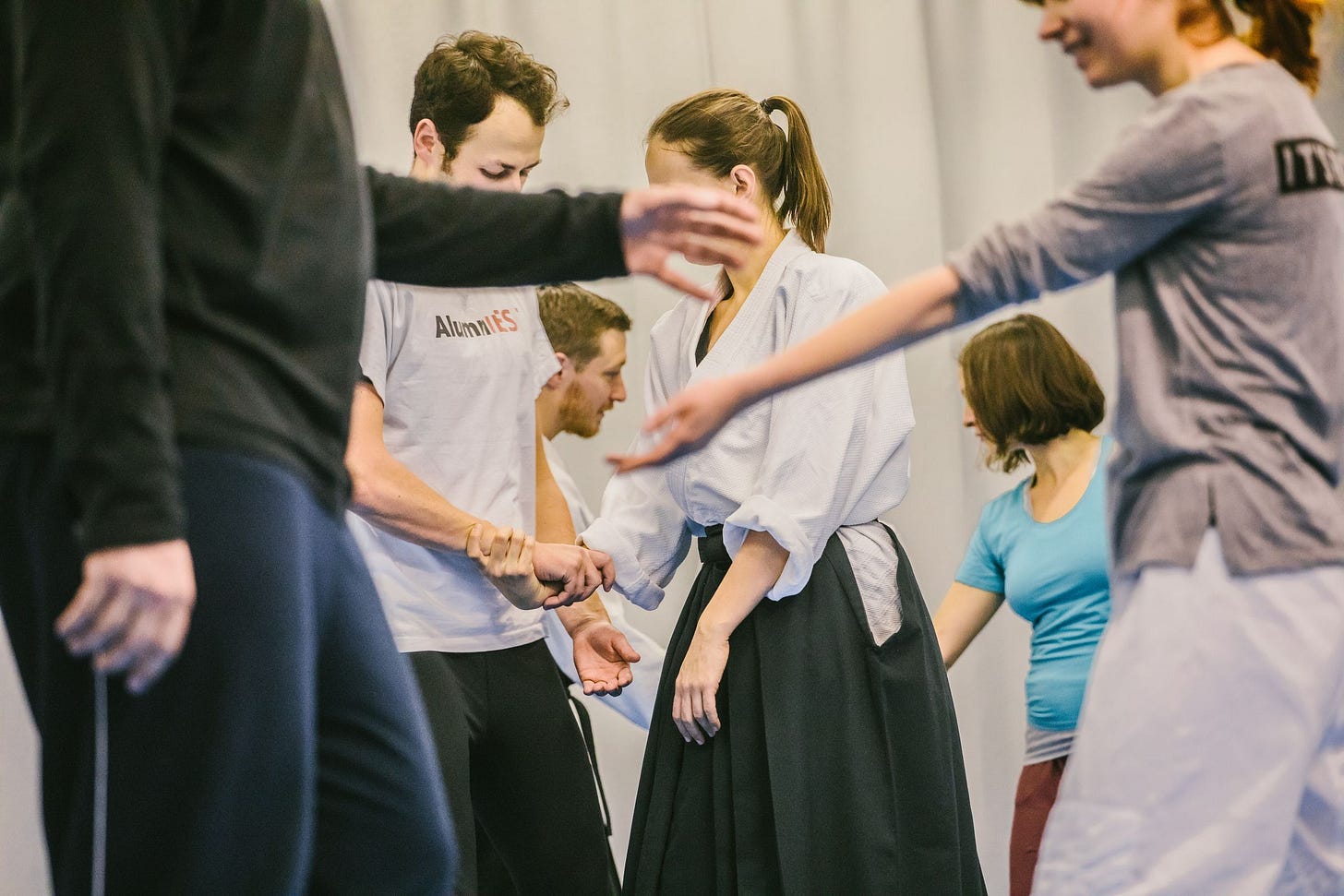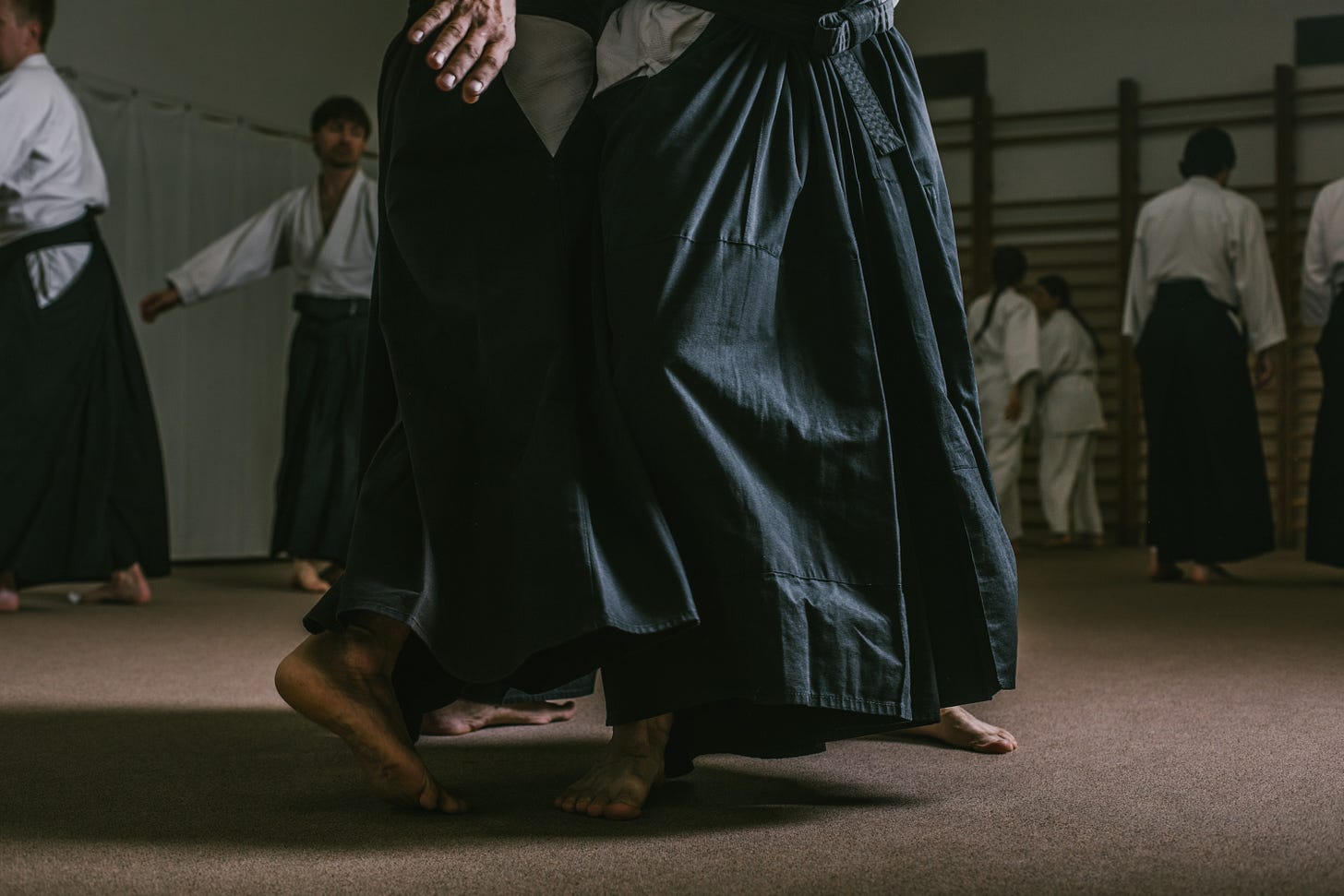Aikido has the power to enrich us in every moment of practice—if we allow it. There's a common myth that Aikido only "works" after ten or twenty years of training. But in reality, Aikido should work from the very first session, from the very first steps on the tatami.
Do you remember the first time you entered the dojo? How did everything feel new and unfamiliar? That mix of uncertainty and promising possibilities?
Beginners who come to their first class often linger near the door or stand hesitantly at the edge of the mat. Then, suddenly, class begins, and they must take a few steps forward and sit among the more experienced students. They take their first steps onto the tatami—and at the same time, an important step into Aikido practice.
Soon, they will be practicing techniques, attacking, and falling. From the outside, the class will look like a purely physical activity. But behind every movement lies meaning—one that can enrich their lives.
Let’s take a closer look.
Attack as a Lesson of Appropriate Action
In Aikido, the attack precedes the technique—before we can practice a technique, someone must attack us. And attacking is an interesting phenomenon.
Christian is supposed to attack Anna—he raises his hand and aims to strike her forehead. He knows he won’t actually hit her; Anna will step behind him at the moment of impact. Despite this safety, he still struggles to focus on his target, commit to the action, and fully express his intent in movement. Even when he finally attacks, there’s hesitation in his body—a disconnect between intention and execution.
Anna, on the other hand, has a completely different temperament. She’s excited by the movement, putting too much energy into her attack. She loses balance, and her momentum takes her far past her intended target.
Christian’s caution is natural—our humanity tells us there are better ways to interact than striking others on the head. Anna’s enthusiasm is inspiring. Yet, for them to work together, their attacks must be "just right." So they keep practicing, refining their movement with every repetition. With each attack, they become more confident, precise, and connected.
Step by step, Christian, Anna, and all of us learn that when we relax, intention and movement become one. That a simple step forward—closing the distance and making contact—can be an exercise in decisiveness, clarity of intent, balance, and appropriate action.
So much of what is useful in life can be found in a single attack, in a single step.
Meeting What is Coming
As I mentioned, when Christian attacks, Anna steps behind him and then applies an Aikido technique. Her first movement is a step forward, close behind Christian.
In Aikido, we don’t run from attacks—we meet them to control and redirect them. Taking a step toward an attack and moving into danger can be even more intimidating than attacking.
Anna must overcome the instinct to flinch, pull back, or hide her head between her shoulders. She has to remain calm, keep her head up, and step toward what’s coming.
This ability serves us in daily life as well—knowing how to face what approaches us: challenges, threats, and difficulties. Instead of burying our heads in the sand, we perceive the situation, step forward, and meet it with determination.
Can you think of a better way to live and create?
This approach on the tatami begins to shape our lives after just a few classes.
Fluid Movement and Personal Flow
When beginners like Anna and Christian discover the magic of stepping forward and start learning techniques, a new challenge arises—fluid movement.
At this stage, they know the basic techniques, but their movement looks a bit like a video with a bad internet connection. They hesitate, pausing after each step as if they need to check their balance, think through the next movement, and then—maybe—take action. Maybe.
They freeze in attacks and techniques, hold onto their positions, and physically and metaphorically “don’t want to take the next step.” This is a natural phase of development.
Anna and Christian enjoy training, so they may not even notice how, session by session, their movements become smoother and more continuous. One day, their steps simply start to flow.
Their Aikido—and they themselves—become more alive. They stay present, no longer clinging to what was or worrying too much about what’s going to be. They move with others while staying in their own rhythm, in their own flow.
When I see this change, I smile to myself, knowing they’ve taken another step on their journey. Later, they might tell me they changed jobs, found a partner or that life just started to feel lighter. They’ve taken another personal step forward.
Because the steps we take on the tatami and in daily life are not separate. After all, the person taking them is the same—on the mat, at work, and at home.
When we realize this, Aikido works from the very first class. Every movement and every contact offers a chance for discovery and understanding. And every training session becomes just as miraculous as the first.
What steps forward have you taken in your life thanks to your Aikido practice? Is keiko still so exciting for you as it was when you started?
Related Articles
Read more articles from the cycle Aikido As …




Great reminder, thank you! Coming back to Aikido last year after years away, was my perfect Aikido challenge… I was my own worst attacker, as my self-doubts were standing there trying to blend with the mat. My mind wavered between resisting (“Maybe I should just watch today…”) and overcommitting (“Whoohoo, I am back, folks!”)
And then the shame: why had I stayed away so long? Why did I think I could just walk back in and pick up where I left off?
🙈 But Aikido doesn’t care about my ego, or how long I was gone or how many years I trained before. It just meets me where I am and wants to know, whether I am willing to engage. Because that’s my real practice - not being perfect, just stepping in … and getting bruised 😅.
You make some very good points. It all chimes with my own experiences.